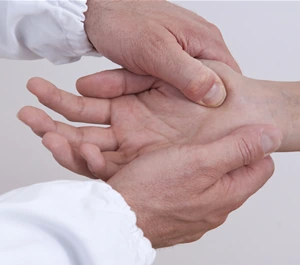Wrist pain / Carpal Tunnel Syndrome
Carpal tunnel syndrome is a compression of the median
nerve as it passes through the carpal tunnel in the wrist.
Pseudo-carpal tunnel syndrome is much more common
and is frequently misdiagnosed as carpal tunnel
syndrome because of the similarity of symptoms.

Signs or Symptoms
- Nocturnal pain in the wrist or hand that interferes with sleep
- Hand weakness; tendency to drop objects
- Difficulty writing or difficulty opening jars. Loss of grip strength
- Tingling, numbness, or pain in the palmar surface of the thumb, index, middle, and half of the index fingers
- Atrophy of the muscles of the thumb
- Sharp, piercing pain shoots through the wrist and arm
- Paresthesia in the hands when walking or running
Description
In true carpal tunnel syndrome (CTS), the median nerve is
compressed—either due to a reduction in the size of the
carpal tunnel itself or an increase in the volume of its
contents. This can result from factors such as swollen
hands, inflamed flexor tendons, a dislocated carpal bone,
or the presence of a neoplasm.
It is essential to distinguish true carpal tunnel syndrome from pseudo-carpal tunnel and other forms of peripheral nerve entrapment. The median nerve
can be lesioned anywhere along its course, from the cervical spine all the way down to the hand. A thorough differential diagnosis is critical to ensure
accurate treatment.
Although repetitive motion is often cited as the primary cause, most cases of
carpal tunnel syndrome are rooted in underlying metabolic imbalances.

In true carpal tunnel syndrome (CTS), the median nerve is
compressed—either due to a reduction in the size of the
carpal tunnel itself or an increase in the volume of its
contents. This can result from factors such as swollen
hands, inflamed flexor tendons, a dislocated carpal bone,
or the presence of a neoplasm.
Common Causes
- Past trauma to the head, neck, shoulder, arms or hands
- Vitamin (B-6) deficiency or other chemical imbalances
- Misalignment of carpal bones and/or radio-ulnar articulation
- Proliferation of the cartilage in the carpal tunnel
- Systemic metabolic problems such as diabetes and hyperinsulism
- Repetitive stress or over use of the hands in compromised mechanical positions
- Connective tissue adhesions on the nerve in the tunnel
- Inflammation in the tunnel
- Inflammation and swelling of the nerve in the tunnel
- Edema in hands and wrists
- Paresthesia in the hands when walking or running
Chiropractic / Applied Kinesiology Approach to Carpal Tunnel Syndrome
Dr. Morrison utilizes standard orthopedic and neurological assessments alongside Applied Kinesiology muscle testing to determine whether symptoms originate locally at the wrist or elbow, or if they are being referred from higher neurological centers, including the cervical spine or brain.
Effective treatment requires a comprehensive view of the condition through the lens of the Triad of Health—addressing structural, chemical, and
emotional components. By evaluating and correcting imbalances in all three areas, therapy becomes more targeted and results are typically deeper and
longer lasting.




